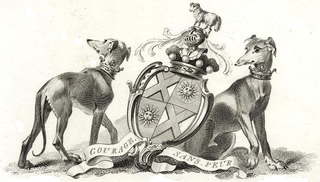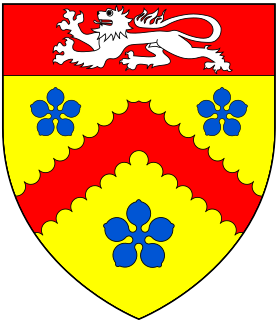This article needs additional citations for verification .(September 2020) |
Sir Thomas Bramhall, 1st Baronet was an Irish landowner and Member of Parliament.
This article needs additional citations for verification .(September 2020) |
Sir Thomas Bramhall, 1st Baronet was an Irish landowner and Member of Parliament.
He was the son and heir of John Bramhall, Archbishop of Armagh, and sat in Parliament for Dungannon from 1661 to 1666. On 31 May 1662, he was created a baronet in the Baronetage of Ireland, and on 25 June 1663 succeeded his father to the family estate of Bramhall Hall, Rathmullyan, County Meath. In 1664 he was High Sheriff of County Louth, and in that year was married to Elizabeth, daughter of Sir Paul Davys, Secretary of State (Ireland) and his second wife Anne Parsons. They had no children, and on his death in Dublin in 1667 his co-heirs were his three sisters. His widow was remarried in 1669 to John Topham LLD (later knighted), Judge Advocate General for Ireland and Vicar General of Dublin. [1]

Earl of Gosford is a title in the Peerage of Ireland. It was created in 1806 for Arthur Acheson, 2nd Viscount Gosford.

Earl of Rosse is a title that has been created twice in the Peerage of Ireland, both times for the Parsons family. "Rosse" refers to New Ross in County Wexford.

Earl of Clanwilliam is a title in the Peerage of Ireland. It was created in 1776 for John Meade, 1st Viscount Clanwilliam. The Meade family descends from Sir John Meade, who represented Dublin University and County Tipperary in the Irish House of Commons and served as Attorney-General to James, Duke of York. In 1703, he was created a Baronet, of Ballintubber in the County of Cork, in the Baronetage of Ireland. His eldest son, Pierce, the second Baronet, died unmarried at an early age and was succeeded by his younger brother Richard, the third Baronet. Richard represented Kinsale in the Irish Parliament.

Viscount Gage, of Castle Island in the County of Kerry of the Kingdom of Ireland, is a title in the Peerage of Ireland. It was created in 1720 for Thomas Gage, along with the subsidiary title of Baron Gage, of Castlebar in the County of Mayo, also in the Peerage of Ireland. In 1744 he also succeeded his cousin as eighth Baronet, of Firle Place. The titles remain united. The Gage family descends from John Gage, who was created a baronet, of Firle Place in the County of Sussex, in the Baronetage of England on 26 March 1622. His great-grandson, the seventh Baronet, represented Seaford in Parliament. He was succeeded by his first cousin, Thomas Gage, 1st Viscount Gage, the eighth Baronet. He sat as a Member of Parliament for Minehead and Tewkesbury and also served as Governor of Barbados. In 1720, 24 years before succeeding in the baronetcy, he was raised to the Peerage of Ireland as Baron Gage and Viscount Gage. His second son was the military commander the Hon. Thomas Gage.

There have been ten baronetcies created for persons with the surname Browne, six in the Baronetage of Great Britain, three in the Baronetage of Ireland and one in the Baronetage of Nova Scotia. Only one creation is extant as of 2010. Three of the creations were for members of the Browne family headed by the Viscount Montagu.
There have been three baronetcies created for persons with the surname Bellingham, one in the Baronetage of England, one in the Baronetage of Ireland and one in the Baronetage of Great Britain. As of 2014 one creation is extant.
There have been six baronetcies created for persons with the surname Brooke, one in the Baronetage of England, one in the Baronetage of Ireland and four in the Baronetage of the United Kingdom. As of 2015 four of the creations are extant, though one has been subsumed into a peerage.

There have been three baronetcies created for members of the Blakiston family of Blakiston, County Durham, two in the Baronetage of England and one in the Baronetage of Great Britain. One creation is extant as of 2008.

There have been seventeen baronetcies for persons with the surname Stewart, ten in the Baronetage of Nova Scotia, one in the Baronetage of Ireland and six in the Baronetage of the United Kingdom. See also Steuart baronets, Henderson-Stewart baronets, MacTaggart-Stewart baronets and Stewart-Clark baronets.
There have been three baronetcies created for persons with the surname Everard, one in the Baronetage of Ireland, one in the Baronetage of England and one in the Baronetage of the United Kingdom. Only one creation is extant as of 2010.
There have been four baronetcies created for persons with the surname Butler; two in the Baronetage of Ireland and two in the Baronetage of the United Kingdom. As of 2014 two of the creations are extant.
There have been four baronetcies created for persons with the surname O'Brien, one in the Baronetage of Ireland and three in the Baronetage of the United Kingdom.
The Colthurst Baronetcy, of Ardrum in the County of Cork, is a title in the Baronetage of Ireland. It was created on 3 August 1744 for John Colthurst, who later represented Doneraile, Youghal, and Castle Martyr in the Irish House of Commons. The second Baronet was an aspiring politician who was killed in a duel. The third Baronet was a member of the Irish Parliament for Longford and Castle Martyr. The fourth Baronet represented Cork City in the British House of Commons from 1812 to 1829. The fifth Baronet sat as Liberal Member of Parliament for Kinsale between 1863 and 1874. He came into the Blarney Castle estate on the death of his father-in-law. The sixth Baronet served as High Sheriff of County Cork. The seventh Baronet was an Army officer in the First World War and a leading figure in Irish cricket. The eighth Baronet was High Sheriff of County Dublin. The ninth Baronet lived in London and did not use the title. Since 2003, the title has been held by his son, the tenth Baronet, who manages the Blarney estate full-time.

There have been three baronetcies created for persons with the surname Cooke, two in the Baronetage of England and one in the Baronetage of Ireland. One creation is extant as of 2013.

There has been six baronetcies created for persons with the surname Shaw, one in the Baronetage of England, one in the Baronetage of Nova Scotia and four in the Baronetage of the United Kingdom. Two of the creations extant as of 2010.
Sir Standish Hartstonge, 1st Baronet was an English-born lawyer who had a distinguished career as a judge in Ireland, but was twice removed from office. He was also a very substantial landowner in Ireland and England. His last years were marked by bitter family disputes with his eldest grandson, who inherited the baronetcy, but not the family estates, which passed to the judge's youngest surviving son.
Sir Paul Davys was an Irish politician and civil servant, who held office as Clerk to the Privy Council of Ireland and later as Secretary of State (Ireland). He had considerable influence in public affairs, and enjoyed the close friendship of the Lord Lieutenant, James Butler, 1st Duke of Ormonde. His sons, William and John, both attained high office. He was the grandfather of Paul Davys, 1st Viscount Mount Cashell.

Sir Percy Freke, 2nd Baronet of West Bilney, Norfolk and Castle Freke, County Cork, was a baronet in the Baronetage of Great Britain and a Member of Parliament in the Irish House of Commons. His first name was sometimes spelt Peircy.
Sir Thomas Burdett, 1st Baronet was an Irish politician and baronet.
Eland Mossom, Esq. M.P. was a lawyer, recorder of the City of Kilkenny, and representative in the Parliament of Ireland for the Borough of St Canice in Irishtown. He was the eldest son of Dean of Kilkenny Robert Mossom. He resided at Mount Eland, near Ballyraggett.